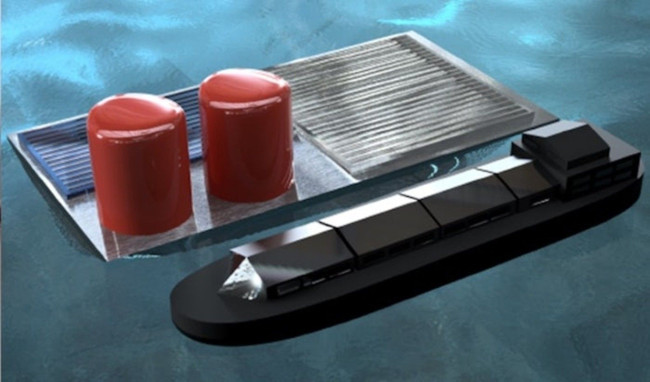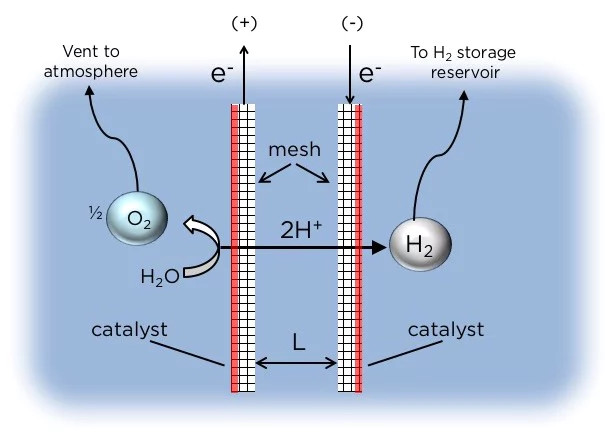Floating equipment can obtain hydrogen gas from seawater
Hydrogen is a clean fuel, but current production methods, usually by converting natural gas, can be harmful to the environment.
Producing hydrogen from the sun and water does not produce CO2, and recent studies have improved efficiency and lowered the cost of devices that achieve this process. Recently, Columbia University engineers are developing a "solar fuel rig" that floats on the sea, can collect energy through a solar battery and use it to collect hydrogen from seawater. .

The rig produces hydrogen through electrolysis of water, separating H2 and O2 gas from the water by passing an electric current through the liquid. Most of the time these same devices require a membrane to separate the two electrodes, but these membranes are quite fragile and need water to be very pure, this is their weakness.
Equipment developed in Columbia can divide water into hydrogen and oxygen without membranes. That means it can be deployed on seawater - the environment is easy to degrade membranes because of impurities and microorganisms.
Jack Davis, the first author of the article describing the device, said: "It is possible to safely demonstrate a device that can perform electrolysis without membranes, helping to get closer to water electrolysis These solar generators are mainly artificial photosynthesis systems, like the photosynthesis process of green plants, so our equipment can open a lot of opportunities to create energy. renewable, green and clean " .

(Photo: Daniel Esposito / Columbia Engineer)
A chart shows how the research team's electrolytic system works: red lines indicate that the catalyst is mounted on one side of each electrode, H2 gas bubbles form along the lateral surface. must be collected into the collection chamber, while O2 bubbles will escape from another vent.
Instead of using membranes, the Columbia system uses two grid electrodes, which are asymmetrically designed. Each pole is coated with a catalyst only on the outside, and air bubbles will be on these surfaces. H2 bubbles formed on one electrode and O2 on the other, and to obtain these gases, this device uses simple physics - in particular, they wait for the bubble to grow large enough to emerge. surface. O2 gas that floats to the surface will escape into the air, while floating H2 (Hydro) bubbles are collected into a collection chamber.
This unique electrolytic mechanism is connected to a photovoltaic cell, producing the required current with the energy obtained from sunlight on an open sensor platform. The whole system can be mounted on a floating surface.
The study is published in the International Hydrogen Energy Journal.
See more:
- Bioplastic biodegradable in natural environment made from shrimp shells
- New molecular printing technology can reproduce a complex chemical environment similar to the human body
- Those who adapt to all habitats are the last survivors
You should read it
- Without electrolysis, splashing a microwave into the water is also capable of generating hydrogen
- Why is seawater salty?
- Roll the list of the best family water filters on the market today
- Ships traveling around the world for 6 years do not need fuel
- What is hydrogen water purifier? Is hydrogen water purifier good?
- It turns out this is the reason why seawater is often blue but the waves are white
- The device removes 99,999% of bacteria in dirty water in just 20 minutes
- Review Kangaroo Hydrogen KG100HA water purifier
May be interested
- Hydrogen bombs, nuclear weapons are 1,000 times more powerful than nuclear bombs
 try comparing to see how different atomic bombs and hydrogen bombs look? how destructive is the power of every bomb.
try comparing to see how different atomic bombs and hydrogen bombs look? how destructive is the power of every bomb. - Interesting facts about the picture of 'devil horns' floating in the sea caused a stir in public opinion
 photograph of demon horns floating in the sea by photographer elias chasiotis taken while traveling to al wakrah, qatar on december 26, 2019. after being published, the photo quickly caused a stir in public opinion.
photograph of demon horns floating in the sea by photographer elias chasiotis taken while traveling to al wakrah, qatar on december 26, 2019. after being published, the photo quickly caused a stir in public opinion. - Revolutionize the heating system
 in the context of the fuel crisis and environmental pollution, antonio meucci public high school in carpi (italy) has a boiler running on green hydrogen.
in the context of the fuel crisis and environmental pollution, antonio meucci public high school in carpi (italy) has a boiler running on green hydrogen. - What does the Hydrogen One look like? Please take a look at the disclosure from Red's partner
 there is very little information available about red's first phone, but a new partnership statement made it easy to imagine what a holographic phone would look like.
there is very little information available about red's first phone, but a new partnership statement made it easy to imagine what a holographic phone would look like. - How to fix the error 'Cannot obtain the app name, failed to save' in NoxPlayer
 when setting up a keyboard on a computer that simulates gestures like on a mobile phone, has there ever been an error cannot obtain the app name, failed to save? if you are in this situation, please follow the following article.
when setting up a keyboard on a computer that simulates gestures like on a mobile phone, has there ever been an error cannot obtain the app name, failed to save? if you are in this situation, please follow the following article. - 8 apps to help you watch YouTube videos in Chrome floating window
 while waiting for google to release the picture-in-picture feature for the web version of youtube, users can use these extensions to play videos anywhere on the web in chrome's floating window.
while waiting for google to release the picture-in-picture feature for the web version of youtube, users can use these extensions to play videos anywhere on the web in chrome's floating window. - Without electrolysis, splashing a microwave into the water is also capable of generating hydrogen
 with just one breakthrough, the group of researchers made the energy industry, the material science branch, the space travel industry excitedly present.
with just one breakthrough, the group of researchers made the energy industry, the material science branch, the space travel industry excitedly present. - The first independent floating nation in the world in the middle of the Pacific will be born in 2020
 the first floating country in the world will be launched in 2020 on the pacific ocean off the island of tahiti in the pacific. this will be an independent nation with its own laws.
the first floating country in the world will be launched in 2020 on the pacific ocean off the island of tahiti in the pacific. this will be an independent nation with its own laws. - Mysterious 9m long log floating vertically for 120 years on the lake
 a tree trunk has been floating in the middle of crater lake, oregon for hundreds of years but has not rotted and is always vertical, instead of horizontal as usual, making many people surprised.
a tree trunk has been floating in the middle of crater lake, oregon for hundreds of years but has not rotted and is always vertical, instead of horizontal as usual, making many people surprised. - Hydrogen - electric flying taxi traveled 841 km only emitting water
 the hydrogen-electric flying taxi prototype of american startup joby aviaiton has completed an 841 km flight while only emitting water.
the hydrogen-electric flying taxi prototype of american startup joby aviaiton has completed an 841 km flight while only emitting water.










 Clean the aquarium yourself thanks to symbiotic relationships between fish and plants in the tank
Clean the aquarium yourself thanks to symbiotic relationships between fish and plants in the tank Microwaves produce a lot of CO2 equivalent to nearly 7 million cars
Microwaves produce a lot of CO2 equivalent to nearly 7 million cars China has just built the world's largest air purifier to solve the problem of dust
China has just built the world's largest air purifier to solve the problem of dust Paper equipment can identify contaminated water
Paper equipment can identify contaminated water The 25-year study shows that rising sea levels are rising
The 25-year study shows that rising sea levels are rising Dubai builds the world's largest waste-to-electricity recycling plant
Dubai builds the world's largest waste-to-electricity recycling plant